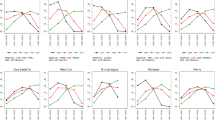Abstract
Theory predicts that workers in cities are more likely to engage in job search, ceteris paribus, due to market efficiencies associated with greater job density. However, if job search is more efficient in urban markets, then the quality of a given job match should also tend to be higher in cities, ceteris paribus. Employed workers living in cities might then be expected to search less than their nonurban counterparts. In this latter instance, it is not city residency itself that makes search less likely, but rather the positive correlation between city residency and job match quality. Using data from the National Longitudinal Survey of Youth 1979, this prediction is confirmed: The estimated coefficient on an indicator of urban residency is found to be near zero and statistically insignificant in models of employed search that omit proxies for job match quality. When job match proxies are included in the models, the estimated coefficient on urban residency becomes positive and highly significant. This result suggests that workers are not only more likely to engage in employed search in urban labor markets, but also tend to find more productive job matches in cities over time.
Similar content being viewed by others
Notes
Fortunately, the specific years chosen for analysis offer some particular advantages. The spacing of the survey dates allows one to capture the employed search behavior of these workers at notable points in the lifecycle. At the time of the 1980 interview, the workers in the sample are in their early twenties; in 1984, they are in their mid-twenties; by the 1996 survey date, they are in their mid-thirties.
An obvious alternative would be to treat only those respondents who reported having conducted search in the past four weeks as on-the-job searchers. This study adopts the more inclusive definition of job search because this is the one employed by Parsons (1991) in his seminal analysis (though Parsons only utilizes the 1980 data in his study.) Nevertheless, the entire analysis is repeated with the alternative measure based exclusively on search conducted in the past four weeks in order to check the robustness of the results.
For respondents working multiple jobs, the job designated as the CPS employer is treated as the primary employment relationship.
This variable is deflated with the yearly CPI-U (1982-84 = 100).
This variable is equal to total yearly net family income less any labor earnings of the respondent. See the NLSY79 Codebook Supplement (Main File) for details on the construction of net family income. This variable is also deflated with the yearly CPI-U (1982-84 = 100).
Similar results are obtained for both men and women when using the alternative measure of employed job search (search conducted in past four weeks). These results are available from the author upon request.
References
Andersson, F., Burgess, S., & Lane, J. I. (2007). Cities, matching, and the productivity gains of agglomeration. Journal of Urban Economics, 61(1), 112–128. doi:10.1016/j.jue.2006.06.005.
Burdett, K. (1978). A Theory of employee job search and quit rates. The American Economic Review, 68(1), 212–220.
Glaeser, E. L. (1999). Learning in cities. Journal of Urban Economics, 46, 254–277. doi:10.1006/juec.1998.2121.
Glaeser, E. L., & Maré, D. C. (2001). Cities and skills. Journal of Labor Economics, 19, 316–342. doi:10.1086/319563.
Helsey, R. W., & Strange, W. C. (1990). Matching and agglomeration economies in a system of cities. Regional Science and Urban Economics, 28, 189–212. doi:10.1016/0166-0462(90)90004-M.
Kim, S. (1990). Labor heterogeneity, wage bargaining, and agglomeration economies. Journal of Urban Economics, 28, 160–177. doi:10.1016/0094-1190(90)90048-R.
Moretti, E. (2004). Workers’ education, spillovers and productivity: Evidence from plant-level production functions. The American Economic Review, 94(3), 656–690. doi:10.1257/0002828041464623.
Mortensen, D. T. (1986). Job search and labor market analysis. In O. Ashenfelter, & R. Layard (Eds.), Handbook of Labor Economics, 2 (pp. 849–920). Amsterdam: North Holland Press.
Parsons, D. O. (1991). The job search behavior of employed youth. The Review of Economics and Statistics, 73(4), 597–604. doi:10.2307/2109398.
Rauch, J. E. (1993). Productivity gains from geographic concentration of human capital: Evidence from the cities. Journal of Urban Economics, 34(3), 380–400. doi:10.1006/juec.1993.1042.
Sato, Y. (2001). Labor heterogeneity in an urban labor market. Journal of Urban Economics, 50, 313–337. doi:10.1006/juec.2001.2219.
Topel, R. H., & Ward, M. P. (1992). Job mobility and the careers of young men. The Quarterly Journal of Economics, 107(2), 439–479. doi:10.2307/2118478.
Wheeler, C. H. (2006). Cities and the growth of wages among young workers: Evidence from the NLSY. Journal of Urban Economics, 60(2), 162–184. doi:10.1016/j.jue.2006.02.004.
Yankow, J. J. (2006). Why do cities pay more? An empirical examination of some competing theories of the urban wage premium. Journal of Urban Economics, 60(2), 139–161. doi:10.1016/j.jue.2006.03.004.
Author information
Authors and Affiliations
Corresponding author
Rights and permissions
About this article
Cite this article
Yankow, J.J. Some Empirical Evidence of the Efficacy of Job Matching in Urban Labor Markets. Int Adv Econ Res 15, 233–244 (2009). https://doi.org/10.1007/s11294-009-9206-y
Received:
Accepted:
Published:
Issue Date:
DOI: https://doi.org/10.1007/s11294-009-9206-y




